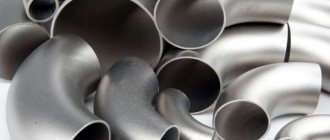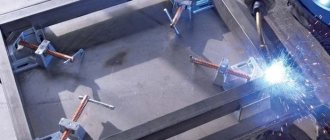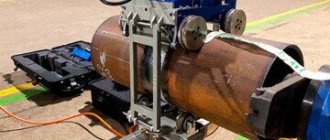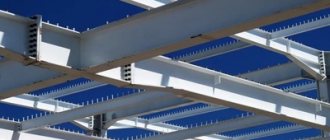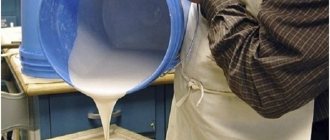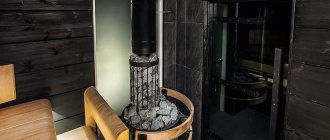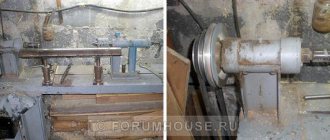The professional path of a home welder is quite simple: the purchase of the first welding machine, the first repair, the first attempts to do the job efficiently, and after a while the first customers. It is at the last stage that the welder needs an estimate. An estimate for welding allows you to thoroughly calculate your expenses and income. In addition, the customer will have more confidence in you, since you will be able to provide him with transparent calculations.
There are many ways to determine the price of welding work: from the “by eye” estimation method to painstaking calculations. In this article we will tell you in detail how to evaluate your welding work so as not to lose money. We will also tell you about the factors influencing the price, valuation methods, and teach you how to perform simple calculations.
What influences pricing
To calculate the estimate correctly, you need to understand what factors influence pricing. In simple words, what affects the final cost of your work. There are many factors, but we will highlight the most basic ones that apply to any type of welding.
The first factor is the volume of welding. This is logical; the amount of payment directly depends on the amount of work. But in addition to volumes, the complexity of the welding process, the type of welding chosen and the number of consumables used in welding must be taken into account. Agree, fast arc welding with electrodes is several times cheaper than semi-automatic welding using tungsten rods and gas.
Later we will tell you which formula to use in order to correctly calculate your welding work. Using the formula, you can set the optimal tariff for welding work. In the meantime, let's talk about methods for assessing welding work.
Work evaluation methods
Before you learn how to do the math, familiarize yourself with methods for estimating welding costs. After all, in addition to mathematical calculations, there are other methods. This knowledge will be useful both to home welders who want to make estimates, and to industrial craftsmen who are tasked with independently estimating the cost of their work.
There is no uniform classification of methods. But we will highlight the main ones, which are most common and easy to use.
Visual assessment
The simplest assessment of the cost of metal structures is visual, or “by eye” (as home craftsmen often call it). This is a very unstable and controversial method, but it is the most accessible of all and does not require any knowledge at all. Often, this method is used in their work by beginners or craftsmen who make simple metal structures (for example, greenhouse frames).
In such cases, the master takes into account the time and materials spent, and also evaluates his customer. If the latter looks wealthy, then most likely the master will ask for a higher price.
There is also a hybrid of visual assessment and calculation. Everything is simple here: the cost of the metal (which is often estimated just “by eye”), which was required for the manufacture of a metal structure, is taken and multiplied by 2. Again, a rather primitive method, but quite effective if welding is not your main income.
Mathematical calculation
The most common method. We have already talked about it earlier. To make a mathematical calculation, special formulas are used. The estimate is most often generated on a computer in a special program.
We would like to tell you separately about an interesting technique that allows you to quite simply calculate tariffs for your work. The essence of the technique is to break down all the components of welding so that they can be easily assessed. First you need to determine the cost of the metal and consumables necessary to carry out welding work in an industrial or home environment.
Let's summarize these indicators. We get the amount that needs to be written down. These are our main expenses. Next, we determine how difficult the welding will be (conventional arc welding or resistance welding to be performed, for example). Sets the cost (the more complex the welding, the more expensive it is). The labor intensity of production and the time spent on work are also taken into account. This is overhead.
Now let's sum up overhead and basic expenses. This is the cost of welding. You need to add profit on top or factor it into overhead costs in advance. Calculating the cost using the mathematical method is quite simple and does not require special knowledge.
Next, we will tell you how to calculate the cost of welding using a simple formula.
This user agreement (hereinafter referred to as the Agreement) is a public offer (that is, an offer to conclude an agreement).
By clicking the buttons “Get a commercial offer”, “Register”, “Submit a request”, “Send a message”, “Request a call back” and other buttons to submit these forms, you are considered to have joined it.
If legislation changes, the Agreement may be subject to changes.
If you believe that the Agreement or the Site Administration violates your rights, please report it by email: [email protected]
1. Terms used in this Agreement:
1.1. A website is a collection of texts, graphic elements, design, images, program code, photo and video materials and other results of intellectual activity contained on the Internet under the domain name https://general-smeta.ru
1.2. The Site Administration is a person who has the rights to administer the Site.
1.3. User is any person who has logged into the Site and accepted the terms of this Agreement, regardless of the fact of completing the registration and authorization procedures.
2. Use of personal data
2.1. By accepting the terms of this agreement, the User provides the Site Administration with consent to the processing of their personal data.
2.2. Purpose of processing personal data: fulfillment by the Administration of its obligations to the User under this Agreement, promotion of goods and services, customer support.
2.3. The following personal data is subject to processing:
2.3.1. Last name, first name, patronymic of the User;
2.3.2. User's email address (Email);
2.3.3. User's phone number.
2.4. Processing of personal data means the following list of actions with personal data: collection, recording, systematization, accumulation, storage, clarification (updating, changing), extraction, use, transfer (distribution, providing access), depersonalization, blocking, deletion, destruction of personal data .
2.5. Personal data is obtained in connection with the conclusion of an agreement to which the subject of personal data is a party. Personal data is not distributed or provided to third parties without the consent of the personal data subject and is used by the operator solely for the execution of the specified agreement and the conclusion of contracts with the personal data subject.
2.6. The Administration has the right to send informational messages, including advertising messages, to the User’s email. The user has the right to refuse to receive advertising and other information without explaining the reasons for refusal by informing the Administration about his refusal by any phone number listed on the Site, or by sending a corresponding application to the email address [email protected] , or by clicking the “Unsubscribe” button contained in each information message. Service messages informing the User about the order and the stages of its processing are sent automatically and cannot be rejected by the User.
2.7. This consent to the processing of personal data is valid indefinitely, but can be revoked by the subject of personal data on the basis of a personal statement sent by email to the Site Administration.
2.8. The Site Administration undertakes to use the User’s personal data obtained as a result of using the Site in accordance with the requirements of the legislation on the protection of personal data, including Federal Law No. 152-FZ of February 22, 2017 “On Personal Data” as amended in force at the time of processing such personal data data.
3. By joining this Agreement and leaving your data on the Site, by filling out the fields of the online application, the User:
- confirms that the personal data specified by him belongs to him personally;
- acknowledges and confirms that he has carefully and fully read this Agreement and the conditions contained therein for the processing of his personal data indicated by him in the fields of the online application on the website;
- acknowledges and confirms that all provisions of this Agreement and the conditions for the processing of his personal data are clear to him;
- expresses agreement with the terms of processing of personal data without any reservations or restrictions.
3.1 The User confirms that, by accepting the terms of the Agreement, he acts freely, of his own free will and in his own interest.
Calculation formula
Where twork is the time you spent working;
td is the time you spent traveling to your workplace (an optional item in the calculations);
ST is your hourly work rate;
Zd - your costs for gasoline (optional item in the calculations);
Zmat - the quantity or cost of your consumables;
AO - depreciation of your welding equipment (depreciation is taking into account the natural wear and tear of the equipment).
This method of calculating the cost of welding work is extremely simple and allows you to evaluate the work for both a production welder and a home craftsman. But keep in mind that this is the simplest formula. With its help, the estimate for welding will be undetailed and primitive.
If you perform technologically complex work, then you should think about more serious methods for evaluating your work. Don't forget that when doing homework, prices can be quoted in any currency. And when working in production, only state currency is used.
Sample estimate for construction and finishing works 2022
Formation of estimates for construction and finishing works is a necessary part of the execution of a contract for the construction and repair of various types of objects.
FILESOpen these files online2 files Download a blank estimate form for construction and finishing work .docDownload a sample estimate for construction and finishing work .doc
In what cases is a document drawn up?
An estimate for construction and finishing work can be drawn up in addition to an agreement both between legal entities and individual entrepreneurs, and between individuals. Construction and repair projects can also be very different:
- private houses and apartments;
- buildings and structures owned by commercial organizations or government agencies;
- individual premises or entire complexes of buildings, etc.
What is the document for?
An estimate is a preliminary calculation of the cost of building materials and services.
This document is necessary so that the customer under the contract has a clear idea of what repair and construction costs he will face.
In some estimates, in addition to outlining the actual expenses, the period for carrying out certain works is also included. Once drawn up and endorsed, the document allows the customer to better control the work being performed.
If we consider the role of the estimate from the point of view of accounting, then it is also quite obvious: it is on its basis that in most cases the cost of materials, construction, installation and repair work is written off.
To be more precise, write-off occurs after the customer and contractor sign the primary accounting document: the certificate of completion, but the estimate confirms the accuracy of the cost of work and materials stated in it. The more carefully and detailed the estimate is drawn up, the less likely it is that during the work process any disagreements and controversial issues will arise between the customer and the contractor.
Is it permissible to violate the figures indicated in the estimate?
A special feature of the document is a guarantee that the prices indicated in it will remain unchanged.
Since the estimate is usually preliminary, during the period of actual work (especially if it is long-term), some prices may change significantly. The amount of materials used may also require adjustment.
Usually this possibility is specified in the contract or the estimate itself (for example, that prices can be increased by 10%, etc.).
If there is no such item in the estimate, then all changes must be agreed upon between the customer and the contractor during the execution of the contract, and if the customer does not object, the estimate can be edited.
In situations where the customer does not agree to increase the cost of work stated in the estimate, the contractor has the right to refuse to fulfill the terms of the contract.
Who is authorized to make estimates?
Typically, the responsibility for creating an estimate lies with the head of the structural unit that is directly involved in the execution of work (foreman, head of a workshop, section, etc.). In any case, this must be a person who knows the standards for the consumption of certain building materials, has an idea of their market value, and is also familiar with the rules for drawing up such documents.
How to create a form
Today, there is no unified estimate form, so representatives of enterprises and organizations can draw it up in any form or, if the executing company has a developed and approved standard template, based on its sample. At the same time, regardless of which method is chosen, it is necessary that the structure of the document corresponds to certain standards of office work, and the text includes a number of certain information.
The standard ones are included in the “header”:
- number, place, date of drawing up the form;
- information about the organizations between which a contract for construction and finishing work has been concluded;
- a link is given to the contract itself (its number and date of conclusion are indicated);
- Positions, surnames, first names and patronymics of managers are entered.
Next, in the main part of the document, a table is formed, consisting of several columns and rows. It includes:
- serial number;
- title of works;
- unit of measurement of work (square meters, kilograms, pieces, etc.);
- price per unit of measurement;
- total cost.
If necessary, you can add additional columns (for example, about the quantity and cost of materials used, information about the devices, equipment, and technology used). The length of the table depends on how much work is planned to be carried out. For convenience, the table can be divided into sections depending on the type of work (plumbing, painting, carpentry, installation, etc.).
Under the table you should make a note indicating whether the prices are final or can be adjusted during the work process.

